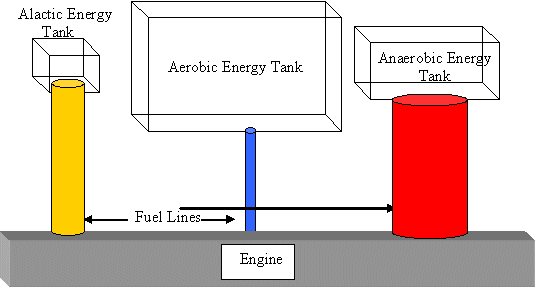

The Running Machine
Lance Smith explains how he enlightens his young athletes about their energy systems.
Knowing a little about the energy systems and how energy becomes movement helps athletes understand why they train the way they do as well as helps the coach explain the purpose of a session or series of sessions. Every training session has a reason, and it certainly helps the athlete if he or she knows what that reason is and how it will affect and have an impact on their performance. The problem, however, is explaining it in a way a teenager, without a scientific interest, can understand and relate to, hence the diagram below.

Fuel Tanks
Consider the body as a machine with a motor connected to three fuel supplies. The first tank is the alactic system, and while it supplies a large amount of fuel, it runs out quickly. The aerobic tank holds a lot, but the fuel line is small, so it does not provide a great amount of energy, but it lasts a long time. Then you have the anaerobic tank that has a large fuel line to provide a lot of energy, but the tank will quickly run out. You use the alactic when starting up and getting going, the aerobic is for cruising, and the anaerobic is for when you need to put the pedal to the floor.
However, it is important to understand that the energy systems work together, with the degree of intensity determining the proportion of energy supplied by each.
Here is how it works
Muscle movement requires a molecule called adenosine triphosphate (ATP). Muscles have enough ATP for around 4 seconds of intense activity. After that, we need to produce further supplies of ATP. The first source is another phosphate found in muscles called creatine phosphate (CP), and we have enough of this for another 12 seconds of hard exercise. This is the alactic energy system - small tank, big fuel pipe. To continue running after this supply is exhausted, we must make ATP from the carbohydrates and fats supplied by the food we eat.
Doing this for any length of time requires oxygen
If you can take in more oxygen than you use you can keep going for as long as the glycogen (fuel provided by the carbohydrates and fats) lasts, and the muscles have the strength to keep going. This is known as aerobic running, or running with oxygen - big fuel tank, narrow fuel line. The procedure is glycogen supplied from carbohydrates and fats changes to pyruvic acid with the pyruvic acid converting to carbon dioxide and water. In both processes, ATP is given off. On the other hand, if we are using oxygen faster than we can take it in, the chemical process changes, and we produce ATP anaerobically - a medium-size tank, a big, wide fuel line. This has glycogen produced from carbohydrates (no fats) being converted to pyruvic acid with ATP given off. But instead of the carbon dioxide and water produced by aerobic running, which is easily disposed of by breathing out, the end product of anaerobic running is lactic acid. This cannot be disposed of until there is sufficient oxygen to spare, so it accumulates in the muscles. This is called oxygen debt. Lactic acid limits performance, and when there is too much for the body to handle, we have to slow down or stop until the debt is repaid.
The basis of training is to get more oxygen into the muscles by improving the efficiency of the aerobic system (heart, lungs, and capillaries) and to teach the body to tolerate oxygen debt by making a bigger anaerobic tank and better fuel line.
In short, if you get more oxygen into the lungs and transport more of it to the muscles, more ATP is made so there is more energy to run faster and longer. And if the onset of oxygen debt is delayed and tolerated longer when it does come, you can hold a faster pace for a greater time. And that is why you train.
Article Reference
This article first appeared in:
- SMITH, L. (2005) The running machine. Brian Mackenzie's Successful Coaching, (ISSN 1745-7513/ 25 / September), p. 5-6
Page Reference
If you quote information from this page in your work, then the reference for this page is:
- SMITH, L. (2005) The running machine [WWW] Available from: https://www.brianmac.co.uk/articles/scni25a3.htm [Accessed
About the Author
Lance Smith is a practising coach with Athletics Southland in New Zealand with coaching qualifications in sprints, track endurance, road and cross country, steeplechase, and high jump and has coached athletes to national championship medals in all the above events. He is also an active "master" athlete and takes part in harriers, track events, and jumps.